Today we are looking at the Slovak and Czech settlement at Slavia, Florida. It was mostly Slovak, but a few Czechs were there, too. In the early 1900s, the American Slovak slogan was Spat ku gazdovstvu, or “Back to the farm.” A number of immigrants from Slovakia felt uncomfortable in their occupations as workers in an industrial society. They wanted their children to grow up on farms where there would be less temptation and wickedness of the large cities.
In 1911, members of the Holy Trinity Slovak Lutheran Church in Cleveland, Ohio, chose two individuals to investigate Florida’s claims of a healthy climate and productive soil. In August of that year, they reported suitable sites near Bartow, Taft and Oviedo. They formed the Slavia Colony Company, headquartered in Cleveland. In October, they began the purchase of 1,200 acres near Oviedo from D.W. Currie and others and the town of Slavia was born…
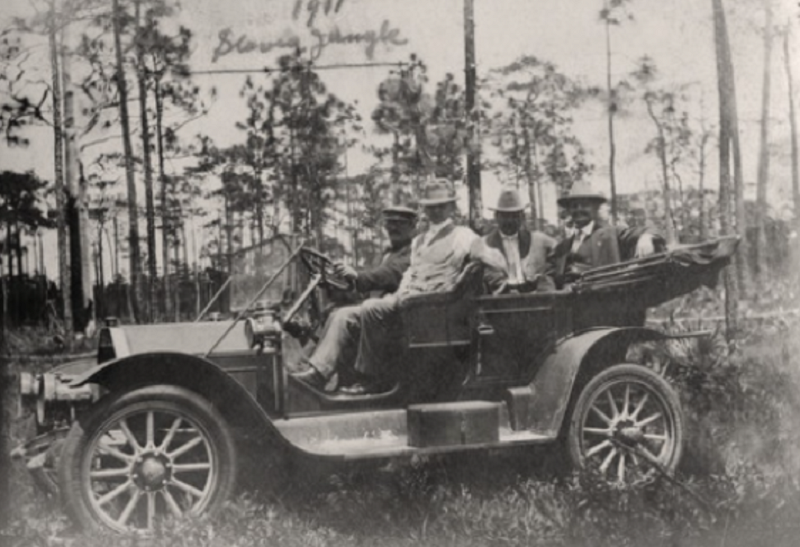
Above: Unidentified men, likely potential investors in the Slavia Colony Land Co., arrive to Slavia, Florida with a driver to inspect what they called ‘the Slavia jungle’ on April 3, 1911
Slavia Founders
Martin Stanko (1880-1950) and Rev. Leopold Alexander Jarosi were the two that the Holy Trinity congregation chose to investigate sites in Florida. Stanko was also one of the five incorporators of the Slavia Colony Company. He served as the President of the congregation of St. Luke’s from 1929 until 1934, after serving a year as one of its two trustees.
Paul Lukas (9/25/1886-1/28/1939) and his family settled in Slavia during 1912. He obtained permission to cut timber which had already been exhausted for turpentine purposes, and managed the colony’s lumber operation. That was the family’s first venture involving plants other than farming, and that is continued today by Paul’s descendants and their nursery business (more below).
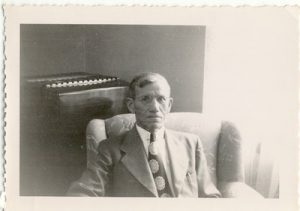 George Jakubcin, Sr. (6/14/1887-6/5/1978) and his wife arrived in Slavia in 1912. Jakubcin started the colony’s first orange grove, but it had to be destroyed because of citrus canker. He traveled around Florida raising funds to help support the colony. He invented a means of quickly traveling between Slavia and Winter Park.
George Jakubcin, Sr. (6/14/1887-6/5/1978) and his wife arrived in Slavia in 1912. Jakubcin started the colony’s first orange grove, but it had to be destroyed because of citrus canker. He traveled around Florida raising funds to help support the colony. He invented a means of quickly traveling between Slavia and Winter Park.
He took a bicycle, removed the tires and added a third tireless wheel off to the side. He place the wheels on the train rails and was able to go much faster than he could on the rutted dirt roads.
George, Jakubcin, Sr., was a charter member of St. Luke’s Lutheran Church and patriarch of one of the Founding Families of Slavia. Photo, c. 1960.
Andrew Duda (11/9/1873-1/20/1958) moved to the U.S. from Czechoslovakia in 1909 and was joined by his wife and four children in 1912. They moved to Slavia and may have tried growing celery by 1913, but if they did it wasn’t successful. By 1915, he was transporting the colony’s children to school in Oviedo. In 1916, after concluding that Slavia was undercapitalized, he gave up and moved back to Cleveland, but returned to Slavia ten years later. When Andrew Duda, Sr. returned from Cleveland in 1926, he founded a partnership with his three sons. This time, he was successful in growing celery. The family farm business grew into one of the nation’s largest. In 1967, the farm switched from celery to sod as its main crop. (More below)
Josef Mikler (1880-1963) was one of the group who, as soon as the land was purchased, immediately wanted to move to Florida. He sold his Cleveland house and boarded the train with his wife and three children. However, they were kicked off the train at the next stop because in their haste they had forgotten to buy tickets. He was still the first to arrive to Slavia, Florida, and in February of 1912 found it cold and wet. He had been expecting warm weather and orange groves.
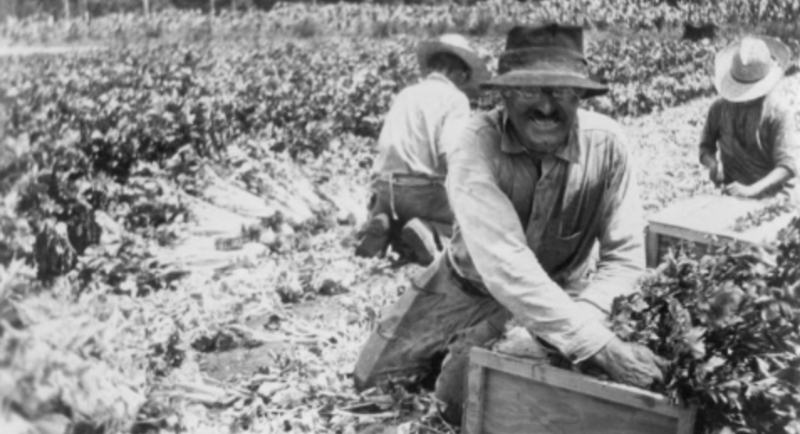
Joseph Mikler, Sr., with unidentified assistants, is on his knees cutting and packing the celery grown on the Mikler family farm in Slavia. c.1920s
They moved into a shack on the west side of the railroad tracks. In the mid-1920s, he began growing celery, a crop then grown by several families. It was carried to Oviedo, where it was transported by train to Atlanta and Savannah.
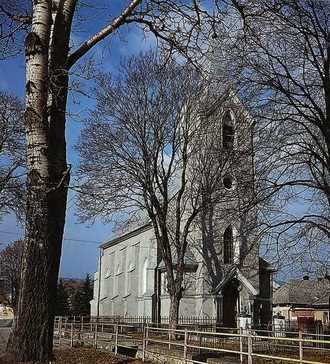 Michael J. Dinda, Jr. (1895-1978) moved to Slavia, Florida with his father in 1913 and for a few years was the only teenager in the colony. He was one of a group of settlers who, in 1920, brought suit to eliminate land claims within Slavia in favor of 34 people, including the men who sold the land to the company. The conflicting claims were resolved in favor of the settlers because by that time, they had fenced the land, cut the timber, and planted crops. Six years later, another similar suit cleared the title to another 850 acres of disputed lands, with the court finding in favor of the settlers.
Michael J. Dinda, Jr. (1895-1978) moved to Slavia, Florida with his father in 1913 and for a few years was the only teenager in the colony. He was one of a group of settlers who, in 1920, brought suit to eliminate land claims within Slavia in favor of 34 people, including the men who sold the land to the company. The conflicting claims were resolved in favor of the settlers because by that time, they had fenced the land, cut the timber, and planted crops. Six years later, another similar suit cleared the title to another 850 acres of disputed lands, with the court finding in favor of the settlers.
Note: To the left is a church from the book Lutheran Churches in Slovakia by Janka Krisova which we wrote about here. Shown is the exterior and interior of the Lutheran (evangelical) church in Slovenske Ves, the original home of the Michael Dinda Family.
The Dinda family emigrated to the US early in the 20th century, settling in OH. Some of the family members became founders of the Slavia community in Florida in 1911 and in the organization of St. Luke’s congregation in March, 1912.
Steven Miroslav Tuhy (10/14/1909-12/26/1967). In the early years, the settlers had to conduct their own religious services. On rare occasions, a visiting clergyman would baptize, confirm, or distribute communion. Rev. Tuhy was installed as the first permanent pastor of St. Luke’s in 1934. He had initially been assigned to St. Luke’s for only six months, but the congregation obtained him on a permanent basis once they offered a monthly salary of $65 plus housing.
Slavia, Florida History
Slavia, Florida is an unincorporated community in Seminole County, Florida. Slavia is located along State Road 426 near the southwest border of Oviedo. In 1911, Lutheran Slovaks originally from what at the time was the Austro-Hungarian Empire (now Slovakia) who were living in Cleveland, Ohio formed the Slavia Colony Company with the goal of establishing a colony in Florida. Behind the name is a story of faith…”great faith,” with which the founding settlers of Slavia were armed.
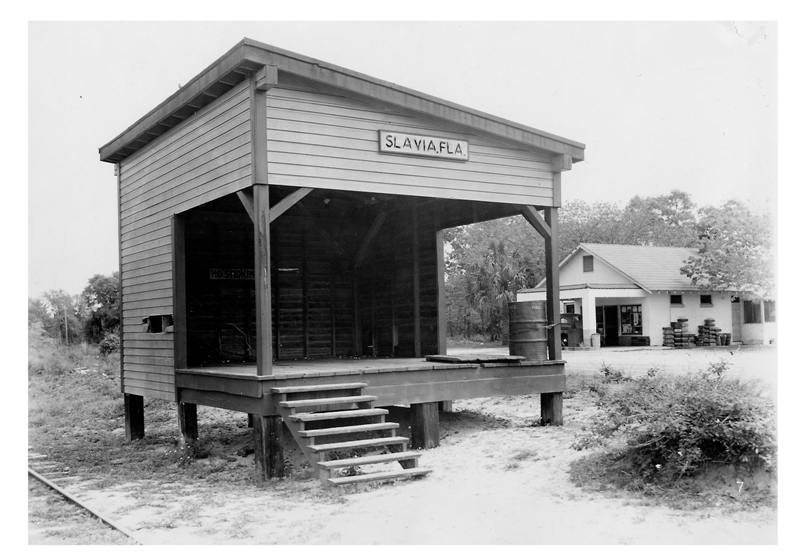
Slavia Depot, general store, ca 1915
Slavia was known to be a small town found east of Orlando right next to the town of Oviedo. It was founded by Czechs and Slovaks. The Czechs and Slovaks who came to central Florida early in the 20th century achieved in founding a Christian environment in which the could raise their kin.
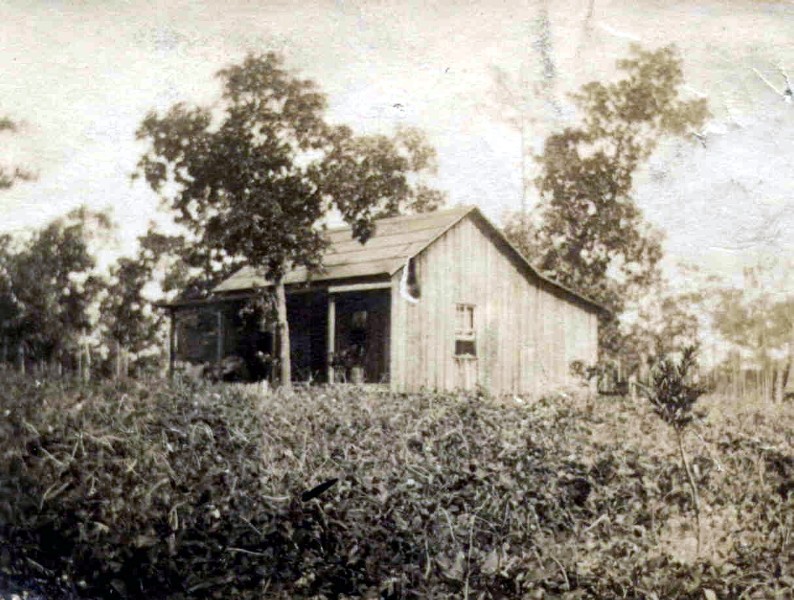
The original settlers of Slavia were part of the Lutheran faith, which is a surprise since most Slovaks followed Catholicism. But during the Protestant Reformation it fell in line with the Slovak culture as well. In 1911 the Slovak community living in Cleveland, Ohio were growing eager to move.
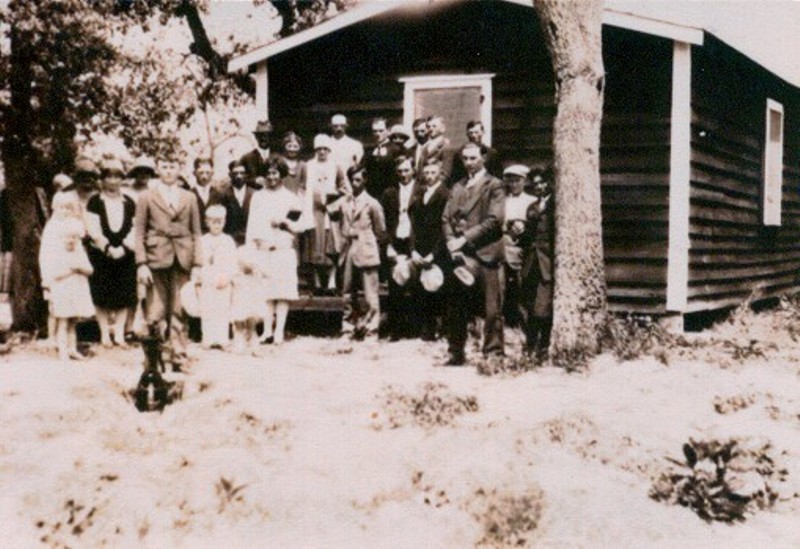
Original Slavia church, congregation
Recent immigrants who came from Europe were uncomfortable in their occupation in the industrial society. “The Holy Trinity Slovak Lutheran Church” in Cleveland, Ohio decided to move many settlers to Central Florida. They felt that keeping their kids away from the industrial city life and moving them towards life of agriculture to be more beneficial.
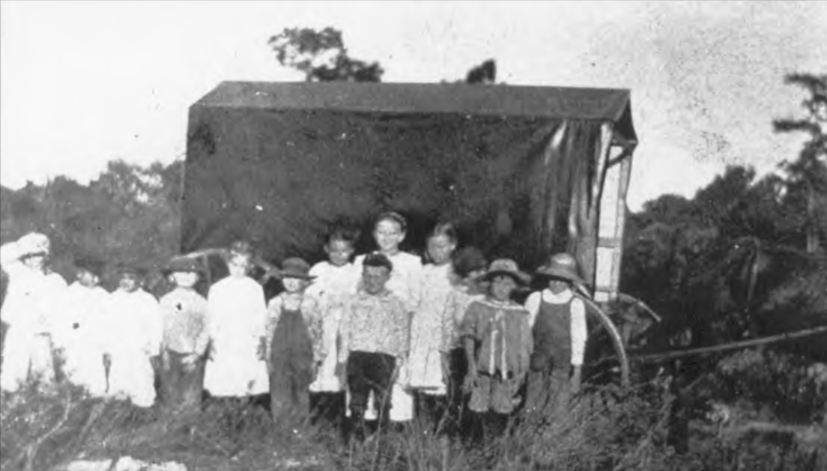
Above: Slavia children (13 in this photo), members of the Hruska, Mikler, Dinda, Duda and Ceman families, attended school in Oviedo. But their transportation, c. 1915, was by a horse-drawn covered wagon, which had to traverse the dirt road between Slavia and the Oviedo school. The driver of the wagon was Anna Duda, one of the oldest students. She is the tallest girl, 5th from right. Visible on top of the photo is the handwritten title: “The Slavia gang going to school.” 5×7 reprint of photo originally taken c. 1915 shows Slavia children standing in front of covered wagon, which was used to transport them to school in Oviedo.
During this time Florida was doing it’s best to recruit people to move to the state. The state of Florida claimed to have a climate that is beneficial to health and also rich soil to produce numerous healthy crops. Many settlers viewed land in Florida as “The Land of Opportunity”.
Many Czechs and Slovaks flocked to Florida in search of a better future.
Visit our other posts: The Czechs of Masaryktown, Florida and Remembering the Czechs of Masaryktown, Florida.
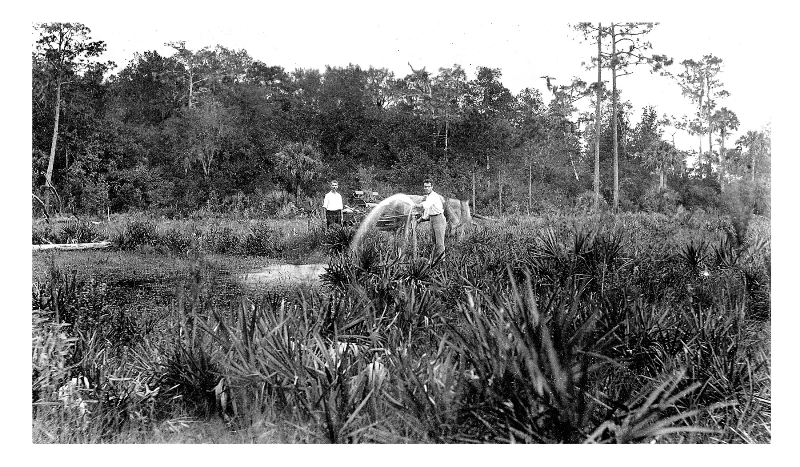
Slavia, Artesian well ca. 1912
On October 7, 1911 the church of Holy Trinity bought 1,200 acres of land for $17,400 which now founded the new town of Slavia. In the beginnings, financial help came from stockholders in Cleveland and from Slovak religious organizations throughout the country.
As months went by the community formed St. Lukes Lutheran Church. As years went by, so did the community of Slavia. The town was a key hot spot for agriculture since they grew citrus, water crest such as celery, turpentine, and even lumber as well. Slavia ended up being a huge supplier of agriculture crops to other small towns at the time such as Oviedo, Sandford and even Winter Park.
Martin Stanko, one of the pair who did the original investigating of the site, didn’t move to Slavia until 1926. When he did, he opened the Stanko Store and sold soft drinks, candy, tobacco and groceries. A gas pump stood right beneath the first “A” in the painted sign. In the 1930s, mail was no longer kept in Maitland for the residents to come and pick up. Unfortunately, their mailboxes were in Gabriella, so they still had to travel two miles to the southwest to get it. Also in the 1930s, electric power lines reached Slavia.
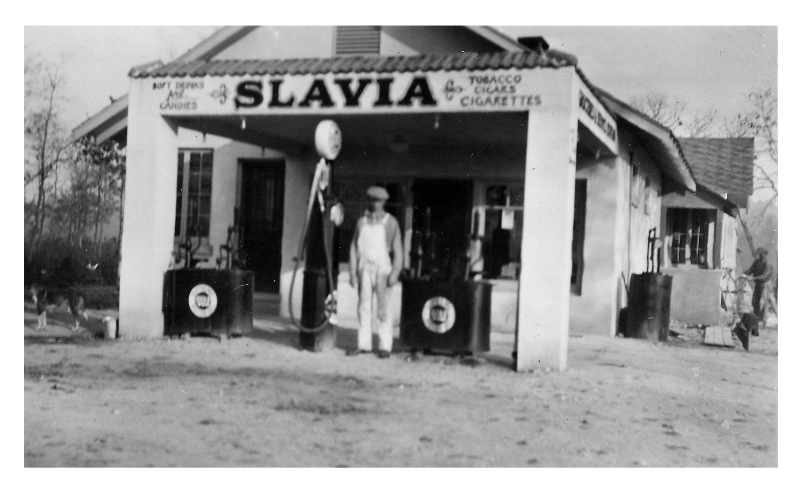
Stanko Store, gas pumps
The way of life for people living in Slavia was in basic terms known as “The Farm Life”.
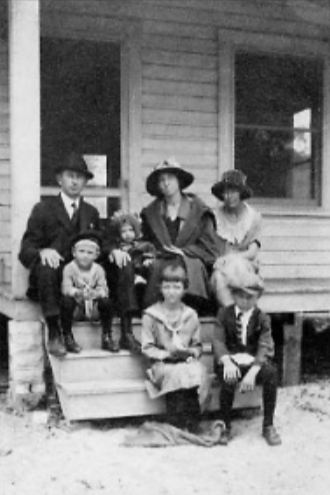
Above: Seated on the porch of their home in Slavia is the Sobek Family, c. 1920. On lower steps: daughter, Ann and son, Andrew, Jr. Left to right on upper step: Andrew, Sr., son, Robert; daughter, Martha, Mrs. Anna Klimek Sobek and a visiting friend.
Some men worked in Henry Overstreet’s shingle mill in Oviedo. Others worked at the citrus packing plant, which by the 1920s employed most of the Slavia residents. Crops which were shipped from Slavia went by train, loaded at the depot located here. It was little more than a small elevated platform with a roof supported by a back wall.
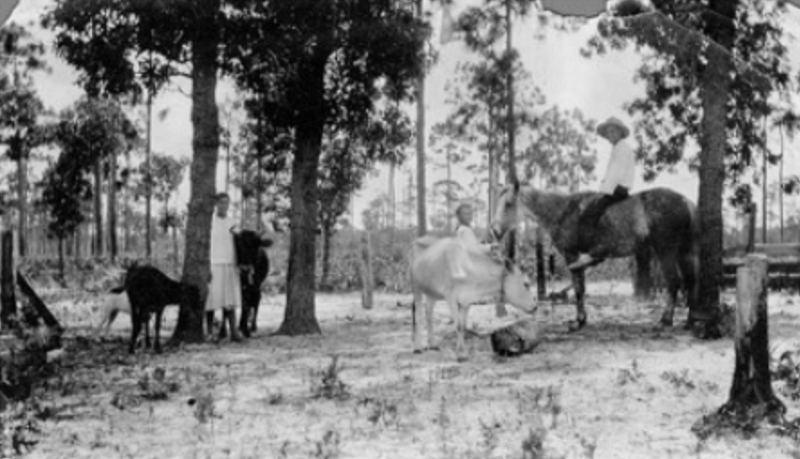
Above: Dinda Family children (c. 1915) with several cattle on their homestead in Slavia. Left to right are: Susan Dinda (with young bull and 2 calves); Helen Dinda (behind white heifer); John Dinda (wearing hat, bareback on horse). Image was scanned (2001) from photo loaned to church for 90th anniversary celebration by the Robert Dinda Family. The edges of the snapshot were damaged when it was removed from a family album in previous years. The children’s names were handwritten in blue ink on the front of the photo and are visible in the bottom margin. This image appeared in Like A Mustard Seed: The Slavia Settlement (Wehr: 1982), courtesy of the Dinda Family.
Children would go to school at the church at St. Lukes and come home and work on the farms tending to the cows, chickens and pigs. And during the weekends kids would then work on the celery farm down the road from them for 10 cents for the whole day.
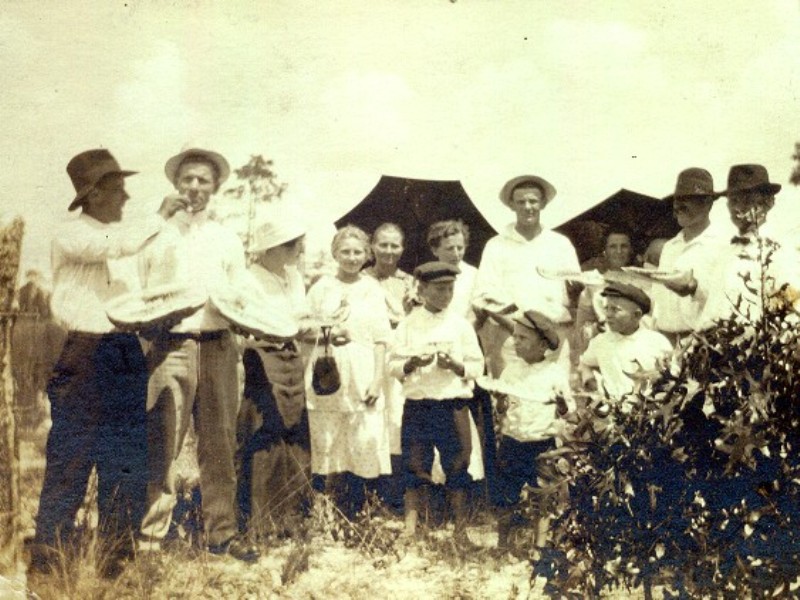
Slavia resident at Picnic, Lake Jesup.
The major celery farm that most people worked on at the time was owned by Slovak immigrants known as the Dudas. To this day Duda has known to be a major reputable company, it is one of the largest company’s in the U.S. and is still thriving.
As celery tended to die out and leave Florida, Duda eventually evolved the company into selling sod commercially and had stretched their farms as far as Vero Beach. By the 1920’s power –lines reached the town of Slavia, and now family homes could enjoy the benefits of electricity.
Also which is now known for purple heart trail that runs through Oviedo, Slavia, Winter Springs and many more central Florida cities now, this trail was once a main railroad track that was used to transport people and agriculture products through out Florida. This shows how Slavia started to adapt to a more modern era.
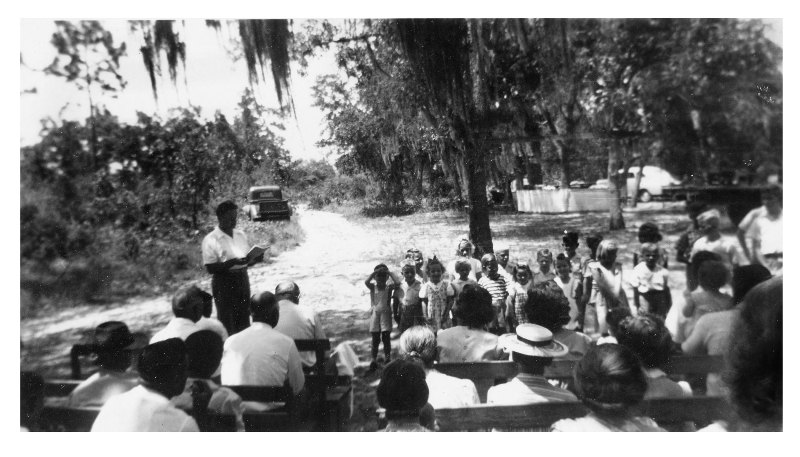
Church School Picnic ca 1946
Other than just living the farm life the people of Slavia lived casual, laid back lives as well. Every Sunday the family’s would attend Sunday mass at St. Lukes Lutheran church and also hang out at the general store located in the heart of Slavia. The children would play games, fish the big canals that ran though the Duda celery farm in which it was trenched out all the way to Lake Jesup, and the elders would play pinochle. Pinochle is known as a card game where you score points by forming combinations of cards and trick-taking, so in a sense it was an older version of poker.
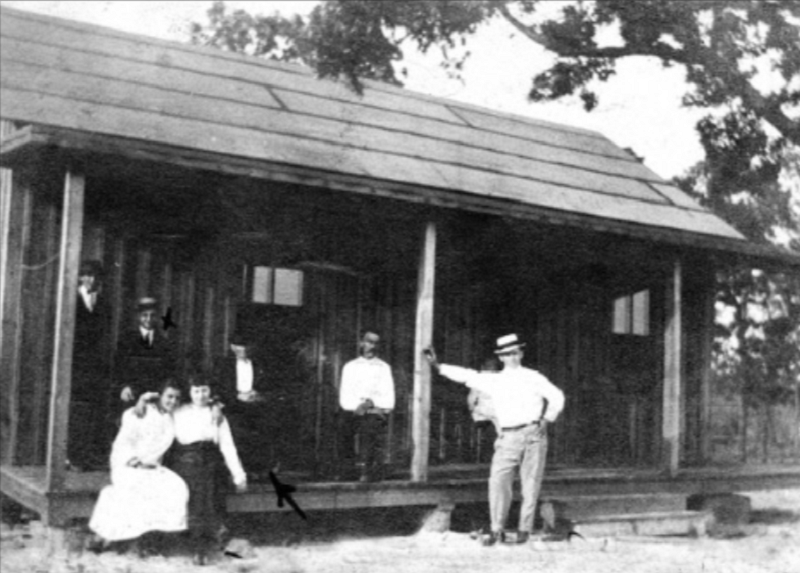
Above: Dinda Family members and friends pose on the porch of the first home they built in Slavia, c. 1915. Pictured left to right: 1. Unidentified, 2. Martin Stanko, 3. Katherine Dinda Senkarik, 4. Mrs. John Stanko, 5. Unidentified, 6. Michael Dinda, Sr., 7. George Jakubcin. Handprinted on the photo are the words: “first home Dinda” with an arrow drawn, pointing to the structure. Also handwritten: “FL Aug 15” (exact year unknown).
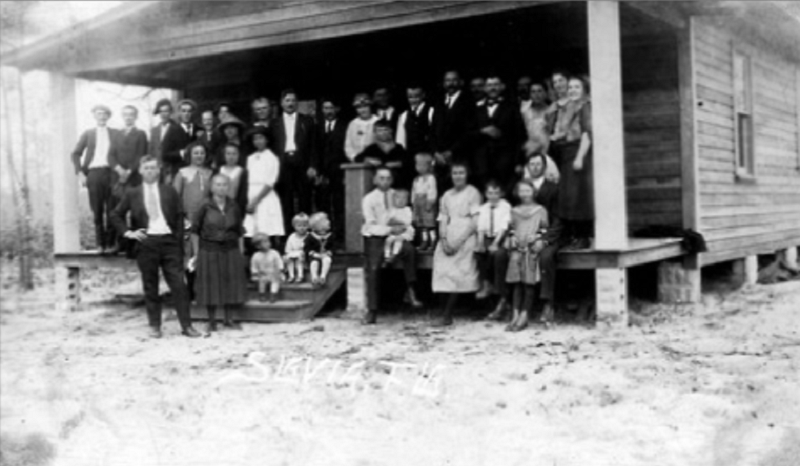
Above: Description of this image as written by Paul Wehr in his book, Like a Mustard Seed (1982) “Gathering at the Klimek home, 1924. Standing in front: George and Anna Jakubcin and their children Emily, Olga and George seated on the steps. Seated on porch: Adam Klimek with child, Mary Lukas, Andrew Sobek, Jr., and Andrew Sobek, Sr., with daughter Ann. Standing near right post, left to right: Maria Lukas, Anna Sobek and Mary Klimek. Others present: John Scerba, Michael Ondic, John Ceman and Vicar Bajus.”
Slavia Agriculture and Social Life
Others would even use their spare time to making grapefruit wine. When December came around for Christmas people would walk into the woods looking for a small pine tree, cutting it down and bringing it home to decorate with ornaments. This shows that the people who lived in Slavia had a positive atmosphere and outgoing social life.
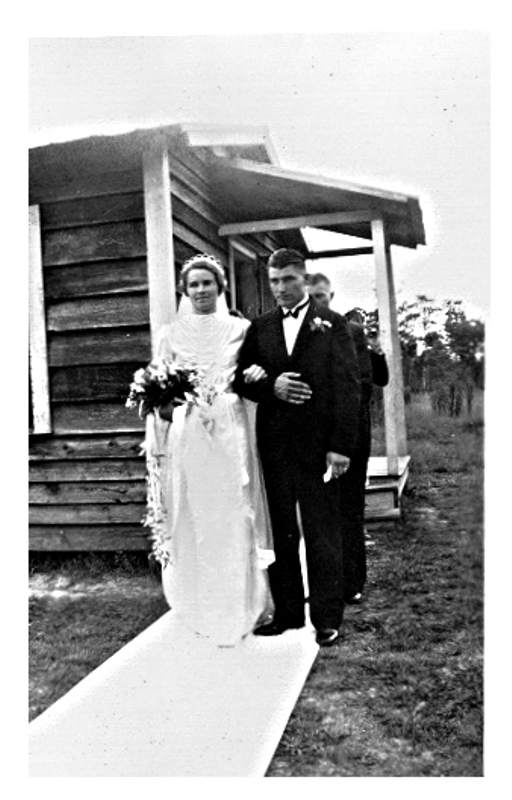
Wedding in first church (Tesinsky)
A urban sprawl expanded around the mid 1960’s, kids started to grow up and start their own families and carry on with their own lives. Many left the small town due to many jobs opening in the major cities such as Orlando, Sandford, Winter Park and Oviedo.
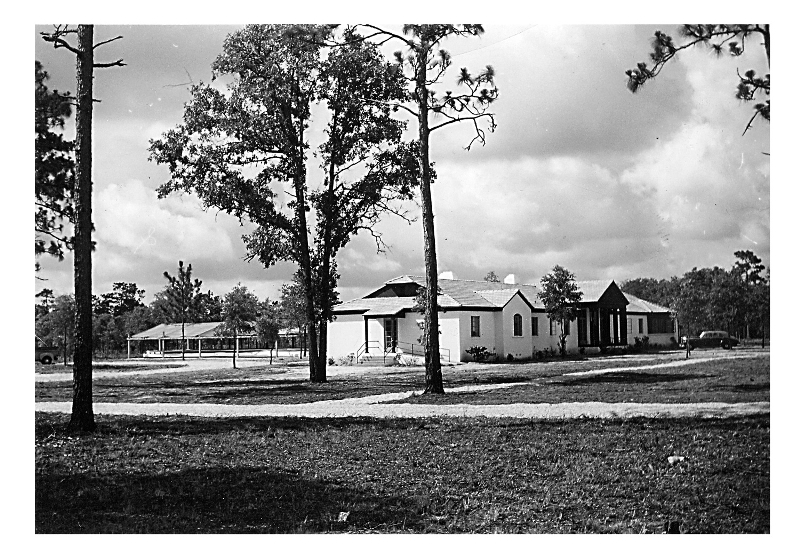
Haven Old Folks home
The Haven facility for Lutherans was chartered as a non-profit home for children and the elderly on May 30, 1948. In the earliest days of Slavia, the residents complained that they rarely ever saw a Lutheran minister, either sent by their home church in Cleveland or the one in downtown Orlando.
After the opening of Lutheran Haven, they had a least a dozen who resided here.
Some say that Slavia as a town/city eventually slowed down and became what they would call a ghost town today.
All that remains are old vacant homes that can be dated back 100+ years as of today, a vacant general store, the original Duda Sod Farm company, St. Lukes cemetery, and the church of St. Lukes.
However, I disagree. Today, Slavia is an unincorporated community in Seminole County, Florida. The exact area is located on Florida State Road 426 just west of the Oviedo City Limits. Some people call it a ghost town, but the businesses that thrive there are 4th and 5tgh generation descendants of the original Slavs who came to this area.
Believe it or not though there are still a few local veterans that still live in the ghost town of Slavia as well. If you do your research you will come to find out what really matters to the community still today and even to the people who left Slavia to expand their future in other directions is that the church keeps everyone tied together to this day.
Even though just a few places exist in this small area – they are long standing and have a rich history and a strong presence.
Lukas Nursery and Butterfly Encounter and St. Lukes Lutheran Church and school lie within the boundaries, both sharing the Slovak history that Slavia is known for.
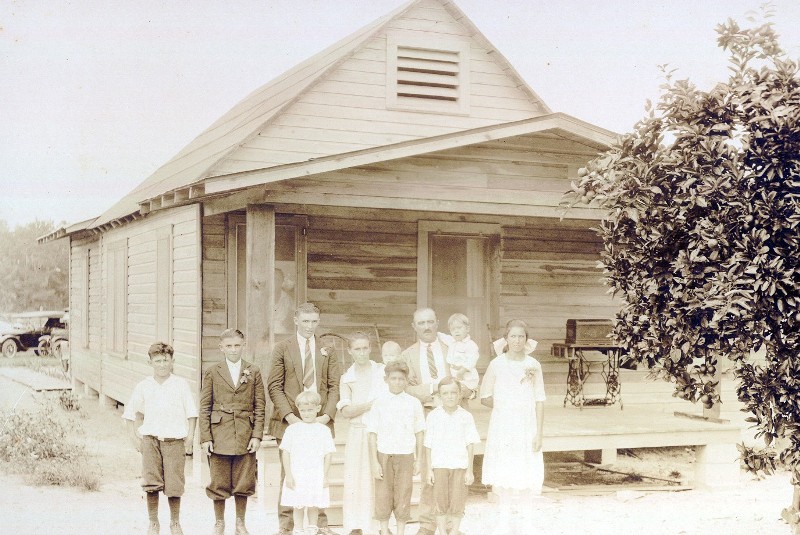
First home built in Slavia, Jos.Miklers (c.1924)
The community of Slavia nestles west of the city of Oviedo.
The area is bisected by a high speed toll road known as the 417 or the Greeneway.
If you’re in the area, you can get a closer look today at Slavia by driving a mile or two north or south on state road 426, or by riding your directly through Slavia on the Cross Seminole Trail, which runs parallel to 426 directly through where Slavia once stood.
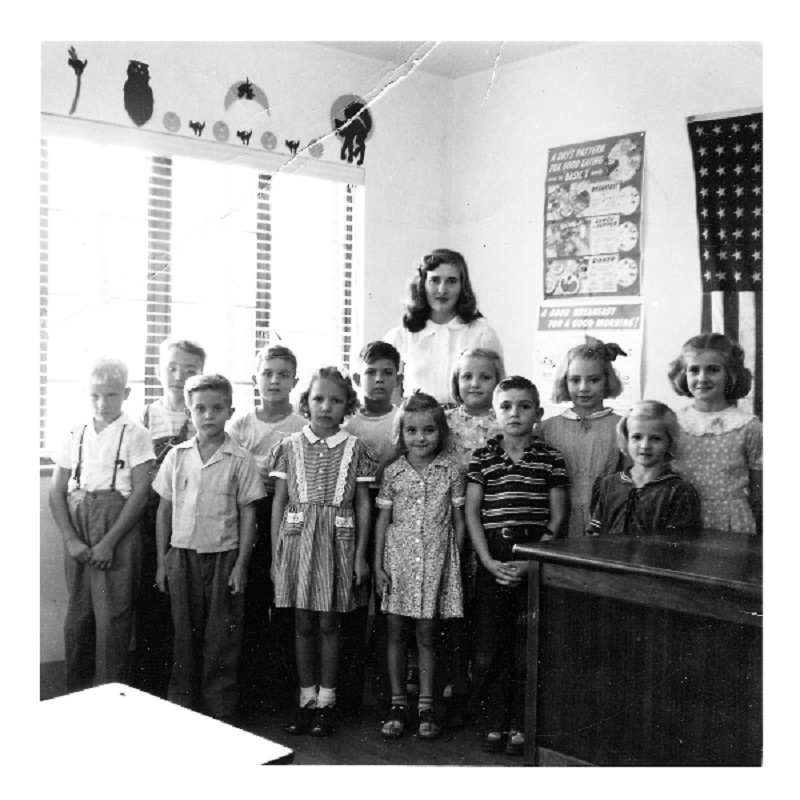
First school, added classroom, teacher ca 1946
You’ll see Lukas Nursery, Saint Luke’s Lutheran Church, a funky pink-colored former gas station, a two story clay-colored building housing A. Duda & Sons, a water tower, and a cemetery. But, that’s about it.
What you will not see – because you can’t see it – is the story of “faith” which grounded the founding families of Slavia 100 years ago. Yet their descendants are still here.
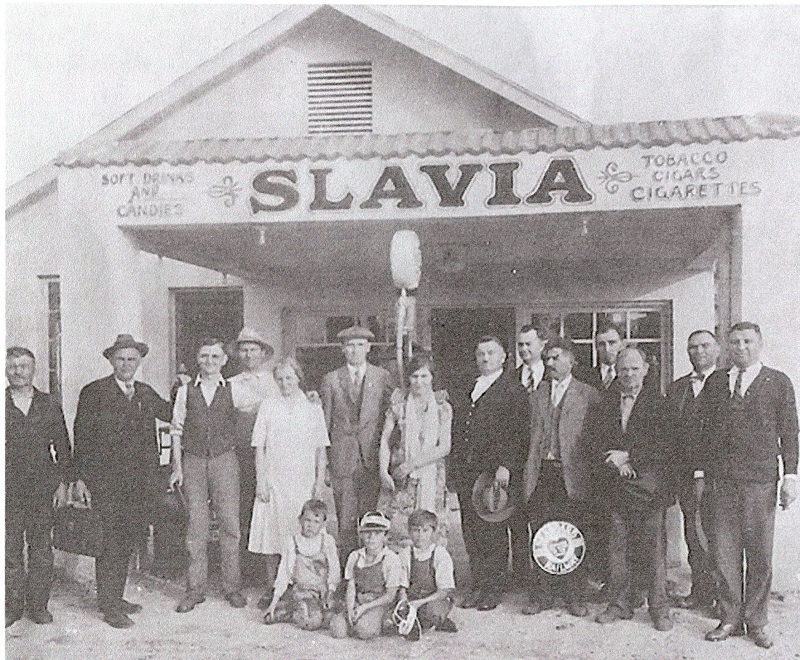
A group of friends and visitors gathers in front of the Stanko general store and service station (which was built in 1926). C. early 1930s. Left to right: 1. Andrew Duda, Sr., 2. Unknown, 3. Martin Stanko, 4. Juliana Stanko. Others in the photo are not identified. Quick video of the Slavia store today.
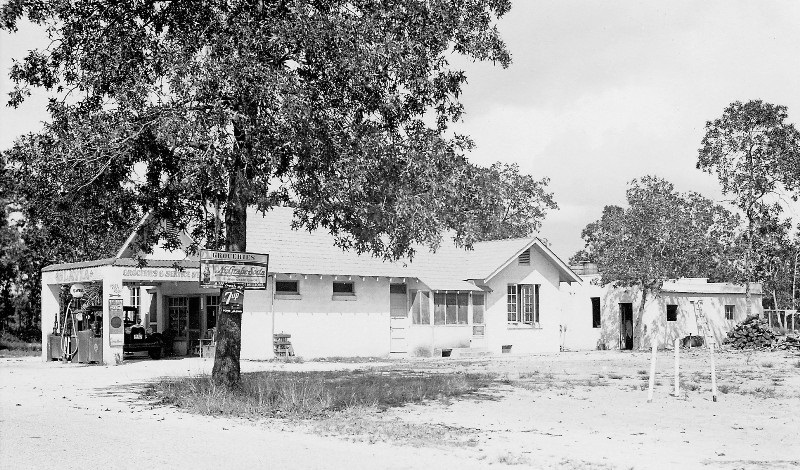
Stanko Store, c. 1918
To experience the story of Slavia, we speak with local Slovakian descendants of two of the founding families of Slavia — Ferdinand S. Duda and Bo Jakubcin.
Listen to some of the interviews here.
Historic footnotes are added by resident Judy Duda and Dr. Paul Wehr, historian and author of Like a Mustard Seed.
History of St. Luke’s Lutheran Church
St. Luke’s Evangelical Lutheran Church has served the Oviedo community since 1912.
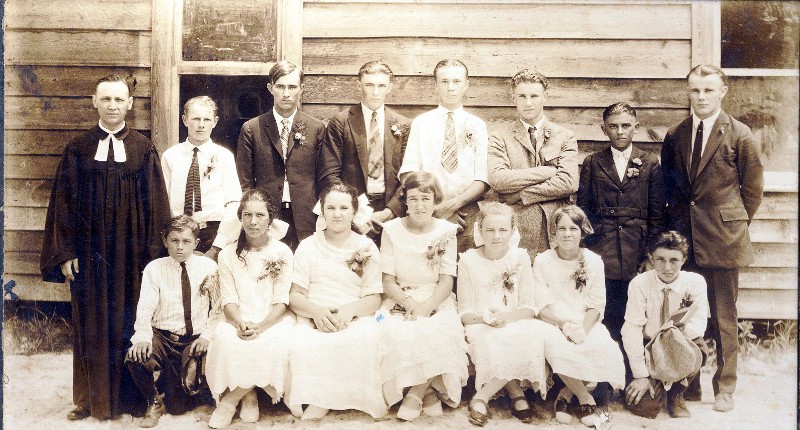
St. Lukes first confirmation 1924St. Lukes first confirmation 1924
The church’s growth has, in many ways, mirrored the growth of the surrounding area. Here are some highlights from the church’s history:
- 1912: St. Luke the Evangelizer Church is founded and their first sanctuary is built.
- 1934: Pastor Stephen M. Tuhy was installed as the 1st full-time pastor.
- 1939: Dedication of the new red-brick structure built as St. Luke’s Evangelical Lutheran Church, at a cost of $7,421.
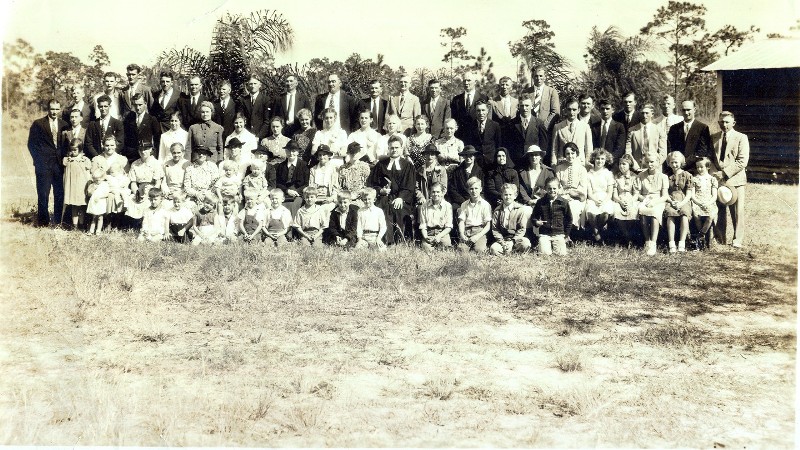
St. Luke’s congregation, C. 1935
- 1947: St. Luke’s Christian Day School opens.
- 1948: Dedication of the Lutheran Haven, built to care for orphaned children and the elderly.
- 1993: Dedication of a new sanctuary and other renovations.
- 2001: New St. Luke’s Lutheran School building is completed and a New Lutheran Haven Early Childhood Center opens.
- 2007: The Lutheran Church of the Redeemer in Sanford, FL is commissioned as a “Partner in Ministry.” and we begin work with The Children of Love Foundation.
- 2016: Our Equipping the Saints program completes the new Family Life Center and additional gymnasium.
- 2022: Celebrating our school’s 75th Anniversary and the congregations 110th Anniversary. Watch the video about the 75 year history of our school.
Watch a video of St. Luke’s first 25 years here:
The early history of the Slavia community and that of St. Luke’s Lutheran Church and School are intricately intertwined. Every member of the community was also a member of the church and the church was at the very heart of the community of Slavia. It’s very name-“Slavia”- can be translated as “Gloria.”
The Slovak settlers who established Slavia Colony in 1911 shared a common language, a common faith and a common vision: to find a place where they could farm their own land and educate their children according to the tenets of their Lutheran heritage.
Photographs, texts and documents from the early 1900s through the century which followed, chronicle the perseverance, self-sacrifice and faith of the founders of St. Luke’s Lutheran Church and School and the ultimate fulfillment of their collective dream.
To shelter their families, the struggling pioneers had only deserted turpentine shacks, in which they also gathered for worship. But within only months of their arrival in Florida, on March 17, 1912, eight of the settlers signed a charter, establishing St. Luke’s Lutheran Church.
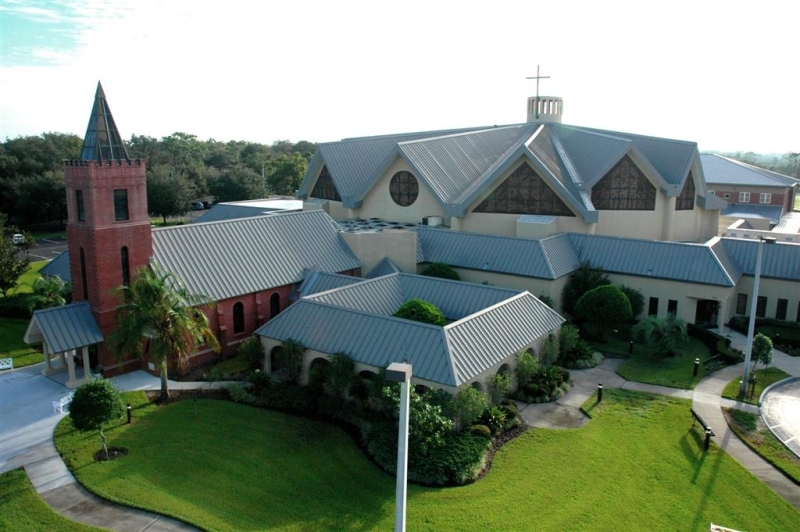
St. Luke’s Church present time
Most of the celery farms of the early settlers have been replaced with residential or commercial properties in recent years and Slavia has evolved into a vibrant and diverse community.
But more than 100 years later, the faith of the Founding Families of Slavia Colony lives on through the outreach ministries of St. Luke’s Lutheran Church. The legacy of the Founders’ sacrificial commitment to Christian education and to the care of children and the elderly is perpetuated through St. Luke’s Lutheran School and the Lutheran Haven Retirement Center.
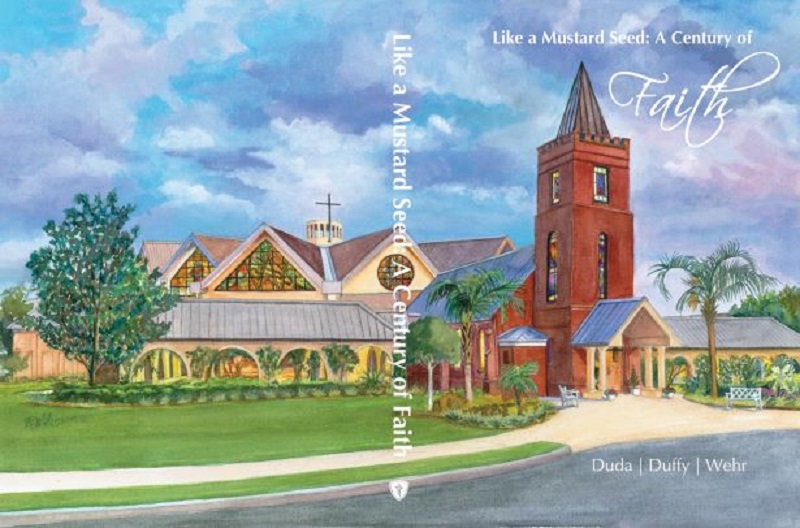
You can purchase the book, Like a Mustard Seed – A Century of Faith, a 300+ page history of our 100 years of blessings at St. Luke’s Lutheran at this link.
Lukas Nursery & Butterfly Encounter
Lukas Nursery is a fourth generation, family owned and operated agri-business. The story of Lukas Nursery and the Lukas family began over one hundred years ago when Paul Lukas and Mary Klimek, two young Czechoslovakians, made separate journeys across the ocean in search of new lives in a free land. Mary arrived in America in 1899 and Paul in 1905, the two meeting in Cleveland, Ohio and marrying in June, 1908.
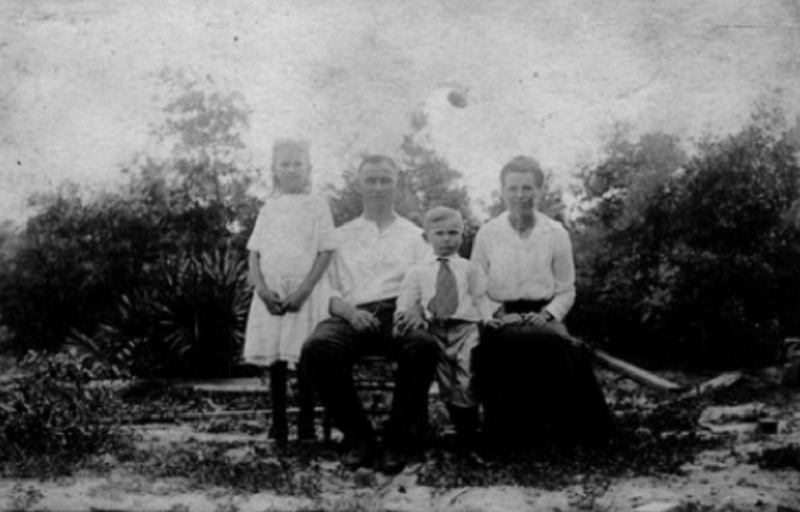
Paul Lukas, Sr. and wife, Maria ‘nee Klimek, at their Slavia homestead with daughter, Mary, and young Paul, Jr. c.1920. Source.
Working hard and saving, the young couple wanted to leave the crowded industrial city for a life of farming. Their dreams were realized in 1911 when they, and six other families, traveled to Florida, settling in the rural and largely empty flatlands near Oviedo. There, in what is now Seminole County, they began farming in 1912 and raised their families, naming the area “Slavia” in keeping with their European heritage. In addition, as devote and practicing Christians, the settlers built a formal house of worship that to this day is one of Oviedo’s most well known landmarks, St. Luke’s Lutheran Church.
Six children were born to Paul and Mary Lukas –Paul Martin, Milton, Daniel, Dusan, Mary, and Mildred. Times were hard, however, so in addition to farming, Paul supplemented their income by driving a horse and wagon to Winter Park where he sold fresh produce to stores and hotels. On occasion, he even extended his stay in town to repair shoes –a trade he acquired before immigrating from Czechoslovakia.
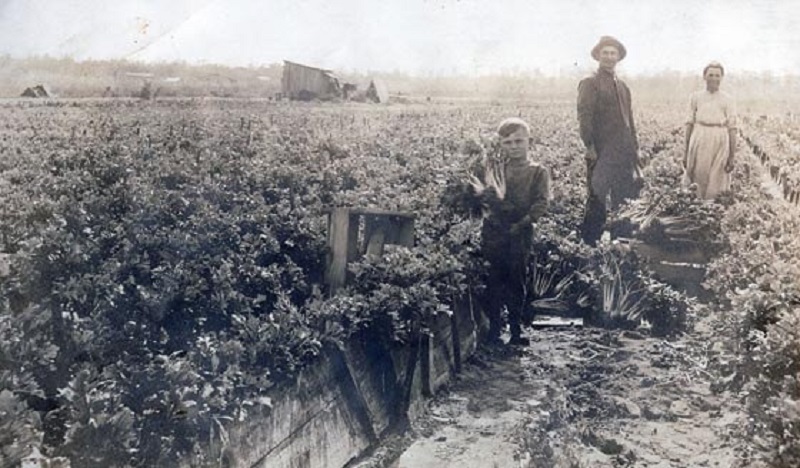
1st & 2nd Generations in Agriculture
Eventually, Paul was able to buy additional land and increase crop production, with father, mother, and children all working hard on the farm to advance the family. After his death in 1939, Paul’s son, Paul Martin, continued truck farming, at the same time looking after his younger brothers and sisters.
Paul Martin married Gertrude Cecelia Greenleaf in 1946. Their union was blessed with four sons –Paul Martin Jr., Jonathan, Philip, and Stanley. After Paul Martin’s untimely death in 1970, his eldest son Paul Martin Jr. realized the small truck farmer’s days were numbered and went out in search of ideas for ways to continue a profitable trade in agriculture. During that time, Gertrude made ends meet by delivering eggs around the community from their “Happy Egg Farm.”
Lukas Nursery was the product of Paul Jr.’s search. Founded in February,1973, the company began with 50 one-gallon cans of woody ornamental plants and a sales area under an old chicken house. Gertrude joined her son Paul Jr. in the nursery business that same year. “Most appropriate for ‘Greenleaf’ to help keep the leaves green,” Paul Jr. said. Within three years, Lukas Nursery had grown from those original 50 containers to two and a half acres of container-grown plants along with its own propagation house.
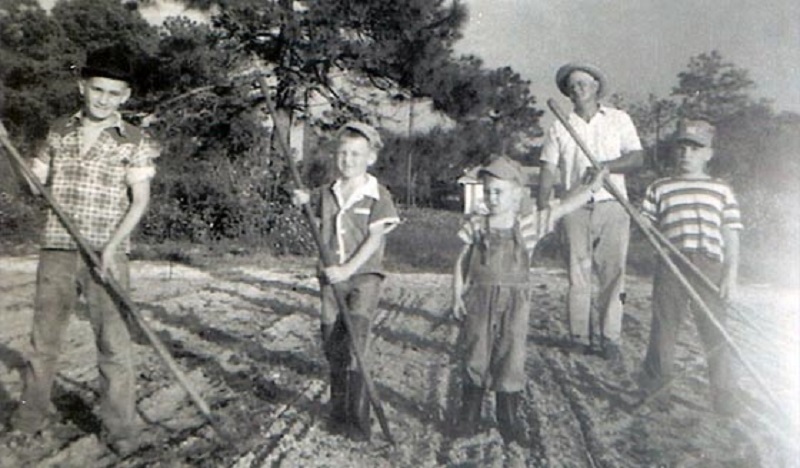
2nd and 3rd Generations in Agriculture
In 1976, Paul Jr. started a foliage nursery on Plymouth Sorrento Road in Apopka, FL, turning the Slavia operation over to his brother Stanley and his mother Gertrude. The two and a half acres expanded to 24 acres of container and field grown plants, with the addition of a new propagation house, potting machine, potting shed, and first official sign.
Lukas Nursery was officially incorporated in December, 1976 with the following officers: Paul M. Lukas Jr., president; Stanley T. Lukas, vice president; Gertrude G. Lukas, secretary/treasurer; and Jonathan S. Lukas, director. Philip Lukas joined the family business in 1977 as a vice president and general manager, and with his knowledge and guidance Lukas Nursery has become a great success, ranking as one of the top 100 independent garden centers in the United States in 2012.
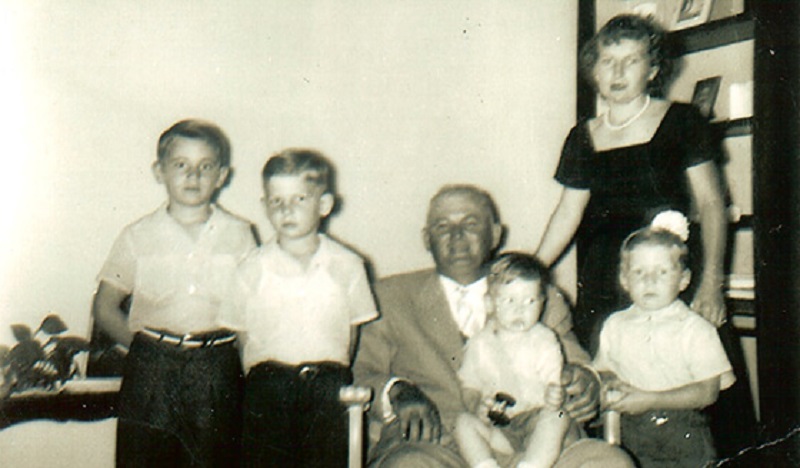
Paul & Gertrude’s Family
Improvements to the business (now “Lukas Nursery & Garden Shop”) include a new sales shop built in 1980 (currently the pottery barn), an even larger sales building and new barn built in 2000, the Butterfly Encounter built in 2004, a new corporate office built in 2012, and a new state-of-the-art greenhouse in 2014.
Shortly after the unexpected death of Stanley Sr. in 2001, the fourth generation of Lukas family members began taking on greater roles and responsibilities in carrying forward the family business and maintaining their agricultural roots. Stanley II, Caleb, and Cecelia (Stanley Sr.’s children) actively pursued stepping into the shoes of their elders, making certain “Lukas Nursery & Butterfly Encounter” remains a vital, growing, 21st century business serving its customers and community. From 2007 – 2016, Lee (Philip’s son) operated Lukas Sod Delivery, offering an extended service to Lukas Nursery’s customers.
We are thankful to God for blessing the labors of our hands and His guidance of our lives. — Gertrude G. Lukas
Take a walk through Lukas Gardens in this video:
Lukas Nursery has served Central Florida for over 100 years.
Visit their website here.
DUDA – A Diversified Land Company
Our Legacy: “To pursue the American Dream – to own land, freely practice his faith, and create a better life for his family.”
DUDA is owned by descendants of Andrew Duda, who emigrated from Slovakia to America in 1909 to pursue the American dream – to own land, freely practice his faith, and create a better life for his family. Among those who founded the small Slovak community of Slavia in Central Florida, Duda and his three sons, John, Andrew, Jr., and Ferdinand, harvested their first cash crop of celery in 1926 and established A. Duda & Sons.
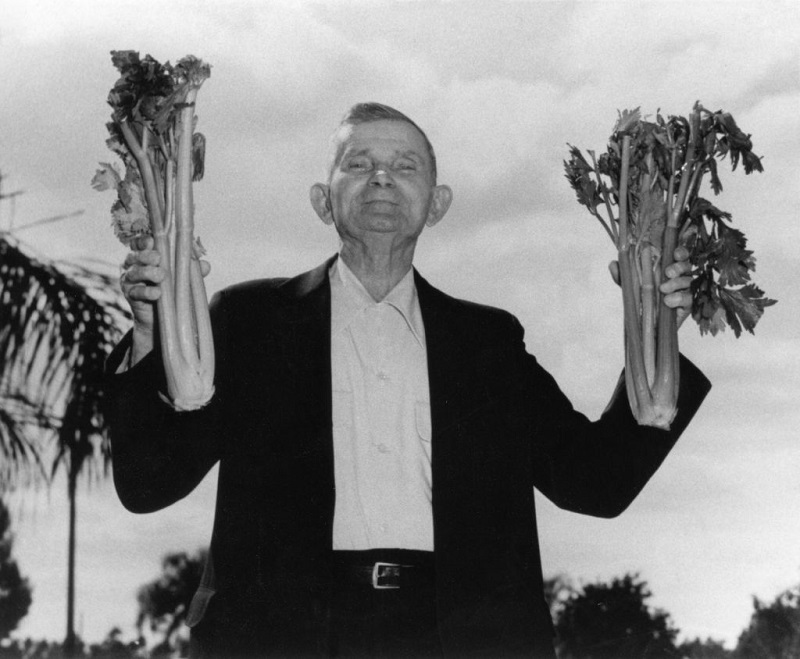
Andrew Duda holding celery
The three brothers were visionary in building the business, acquiring land, diversifying their operations, relying on others inside and outside of the business for advice, having integrity in their business practices and – above all else – trusting in God.
Land has always been at the foundation of DUDA’s strength and success, from the first 40 Florida acres Andrew Duda purchased in the early 1900s to over 45,000 acres owned and leased today across the U.S. Using good stewardship and land management practices, our fifth-generation, family-owned company strives to achieve its corporate mission as a diversified land company through diversified operations and subsidiary companies in agriculture, real estate development and related businesses.
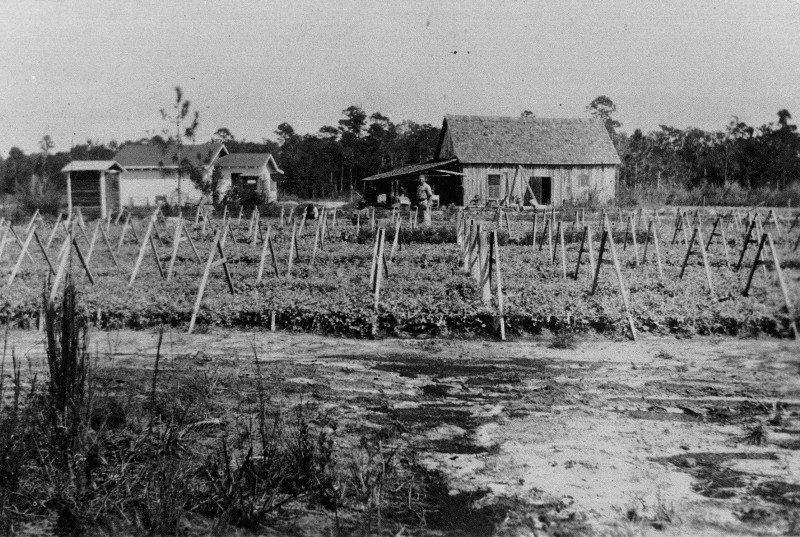
First Duda Homestead, 1926
Starting out as a humble celery farm in 1926, DUDA’s business operations today include Duda Farm Fresh Foods, one of the world’s leading producers and suppliers of celery and other quality fresh and fresh-cut vegetables and citrus; The Viera Company, a highly regarded community developer with fully-integrated real estate operations including Viera Builders, a residential home builder; as well as Duda Ranches, manager of DUDA’s agricultural operations including sod, sugarcane, citrus and cattle.
In the early 1970s, the reins of management were transferred to the third generation sons of the Three Seniors.
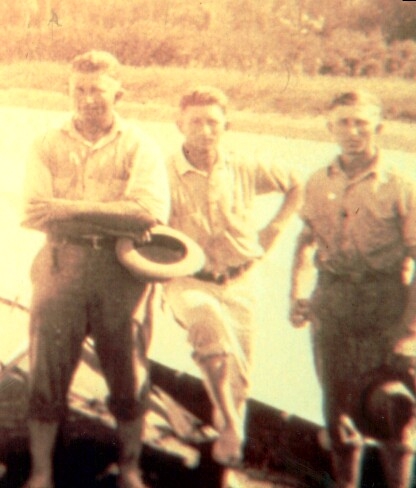
Left to right, Andrew Jr., John, Ferdinand Duda
A more market-driven business strategy was developed for DUDA’s fresh produce operations to satisfy market demands. To offer farm fresh produce year round to their growing customer base, the company acquired farmland in California and Texas. Sod was also added to the company’s agricultural offerings in the 1970s.
In the 1980s, due to the growth of Brevard County, Florida, plans were set in motion to build a master-planned community on DUDA’s Cocoa Ranch. The town of Viera, which means “faith” in Slovak, was established in 1989. Eventually, a home building division, commercial sales division, and a championship golf course were all added to the company’s fully integrated real estate operations.
A short video about the Duda family:
Now in its fourth generation of leadership, the company is professionally managed by men and women of the third, fourth and fifth generations of the Duda Family, and a team of experienced managers. The company is governed by a Board of Directors consisting of six members of the Duda family and four non-family members from varying business backgrounds. In 2004, the Duda family established the Duda Family Council to address some of the governance issues that family businesses in their third and subsequent generations must begin to address. Its mission is: One family, growing together, making an eternal difference. Through elected family representatives, the Council develops processes and structures for the family and owners.
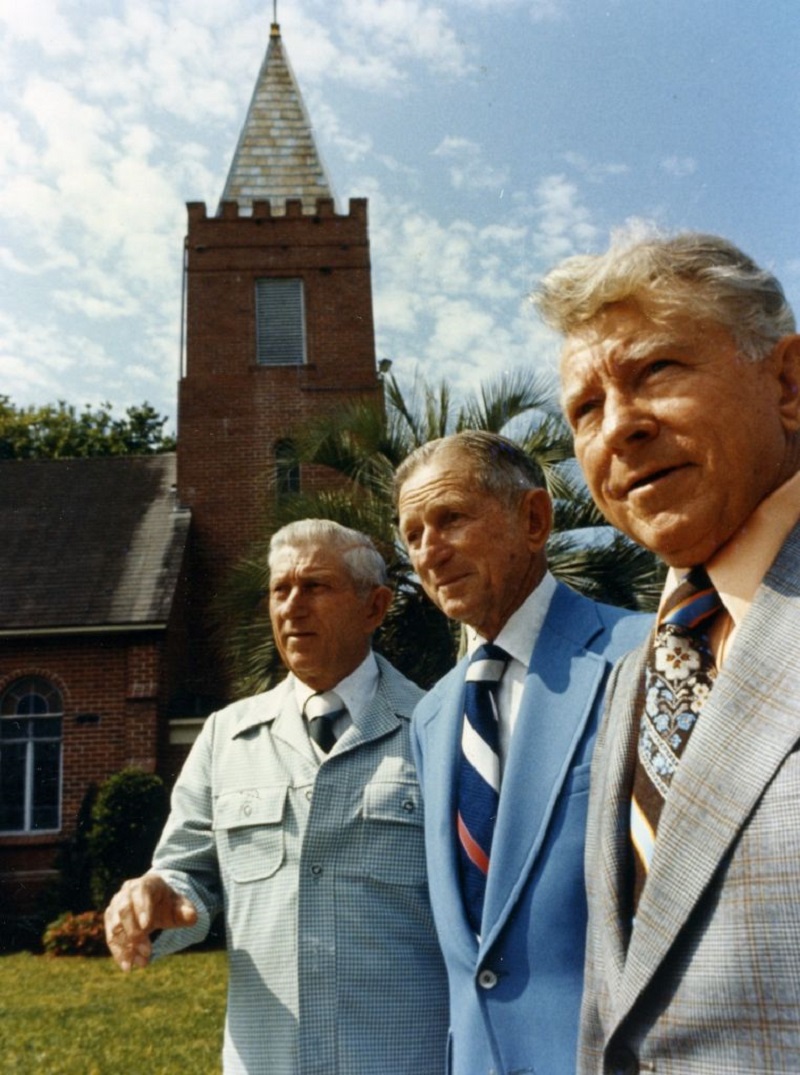
The senior Duda brothers at St. Luke’s Lutheran Church in Slavia, Florida (circa 1980s). Left to right, Ferdinand, John and Andrew Jr.
The importance placed on philanthropy is reflected in DUDA’s stated purpose: We multiply and share God’s blessings. This philosophy is central to all of DUDA’s business operations and actions.
The values passed down from Andrew through each generation at DUDA have earned the company its reputation for quality, integrity and innovation. Its focus on market trends and customer needs has helped the company maintain a competitive edge in all of its business operations. The company has been rewarded by earning recognition for its leadership in business integrity, environmental stewardship and employee benefits.
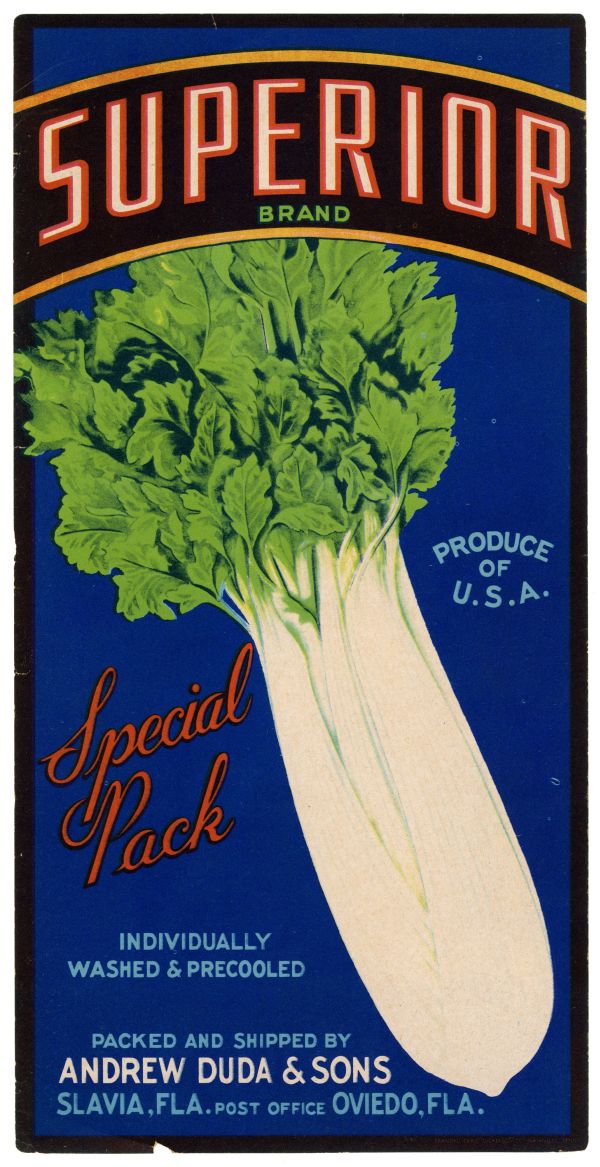
A 1930’s celery label for Superior Brand from Andrew Duda and Sons of Oviedo, Florida.
Learn more about DUDA at their website.
More from the Orlando Sentinel
In 1911, a small group of Czechoslovakian immigrants arrived at a wooded spot in south Seminole County and established a Lutheran community called Slavia.
They started successful farms on fields near where the Oviedo Marketplace and the new Oviedo Medical Center sit and built a church near Chapman Road.
Over the years, Slavia has been all but eclipsed by Seminole’s explosive growth. But a few reminders of the past remain: a road sign on County Road 426, a vacant grocery store with the word “Slavia” above the front door and a cemetery off Chapman that holds the graves of many of Slavia founders.
Now, several Slavia residents are worried about a proposed development on 43 acres on Chapman, just east of State Road 417. They would like to see growth either curtailed or better planned before their quiet community is entirely gone.
“I grew up in this area,” said John Tesinsky, 74, who lives off Chapman Road. “I remember when Chapman was a dirt road, and we used to play there as children. But this place is now growing too fast. Houses just started popping up little by little. Now I’d like to see fewer houses.”
At issue is a Winter Park developer’s request to build 61 single-family homes, 250 apartments and 10,000 square feet of commercial space on the mostly wooded site off Chapman.
Like Tesinsky, other Slavia residents aren’t necessarily opposed to more growth. But they fear that those additional new homes and apartments will bring more traffic to C.R. 426 and their surrounding roads. They would rather see that land be used by high-tech industry that provides jobs for nearby residents.
Clay Archey bought a home off Chapman about a decade ago after marrying Erin Duda, the great-great-granddaughter of Andrew Duda Sr., one of the original founders of Slavia. The Duda family built its global agri-business empire from the small community.
“They came here to start new lives and start businesses,” Archey, 37, said about Slavia’s founders. “And that’s one of the things that we need here today. We’ve got plenty of residences. But what we need now are job opportunities. Otherwise, we are selling ourselves short.”
It was a harsh and miserable experience when the nine Slavak families arrived in the early 1900s. They moved into small abandoned shacks left by the earlier turpentine workers. With no windows and large gaping cracks in the wood floors, they ignited rags and placed them under the floors at night so that smoke would rise through the cracks and drive away the mosquitoes, ticks and horseflies.
Today, one of the last remaining shacks has been rebuilt and serves as a chapel for the cemetery.
It’s important to preserve Slavia’s history, Archey said. He proposes erecting historic markers in the community, especially along the Cross Seminole pedestrian trail, which runs alongside C.R. 426 in Slavia.
Judith Duda, 79, whose first husband was Andrew Duda’s grandson, is Slavia’s unofficial historian and recently co-authored a book, “Like a Mustard Seed: A Century of Faith” that details the community’s past.
Duda said it’s inevitable that growth will soon overtake the small community.
“I’m a pragmatist. Growth is going to happen,” Duda said. “But it has to be smart growth.”
In November, Seminole’s planning and zoning commission recommended the land use change to allow the mixed-use project be denied and sent it to county commissioners. Commissioners were scheduled to hear the request on Jan. 24, but the developer JEL Land Development asked that the hearing be rescheduled for Feb. 28 so representatives could meet with residents.
Bryan Potts, a civil engineer who is working with JEL Land Development on the project, said the developers are willing to work with residents.
“We’re trying to listen to their concerns, and see what we can do to alleviate their concerns,” Potts said.
Rita Pruitt, a 62-year-old Oviedo native who now lives in Slavia, also remembers when most roads in the community were unpaved.
“Slavia is a community that was based on family,” Pruitt said. “It was based on faith. And it was based on growth. But it was smart growth. You can’t have too many rooftops. You need to balance it with industry and well paying jobs.”
Source: Longtime Slavia residents worry about growth, hamlet’s future by Martin E. Comas, Orlando Sentinel, Feb 05, 2017,
Slavia Historical Marker
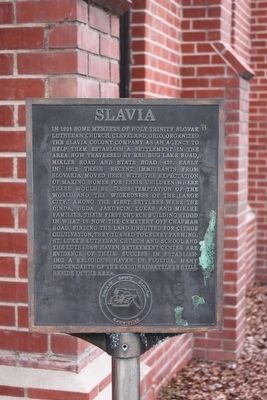 In 1911 some members of Holy Trinity Slovak Lutheran Church, Cleveland, Ohio, organized the Slavia Colony Company as an agency to help them establish a settlement in the area now traversed by Red Bug Lake Road, Mikler Road and State Road 426. Early in 1912 these recent immigrants from Slovakia moved here with the expectation of making homes for their children where there would be “less temptation of the world and the wickedness of the large city.”
In 1911 some members of Holy Trinity Slovak Lutheran Church, Cleveland, Ohio, organized the Slavia Colony Company as an agency to help them establish a settlement in the area now traversed by Red Bug Lake Road, Mikler Road and State Road 426. Early in 1912 these recent immigrants from Slovakia moved here with the expectation of making homes for their children where there would be “less temptation of the world and the wickedness of the large city.”
Among the first settlers to Slavia, Florida were the Dinda, Duda, Jakubcin, Lukas and Mikler families. Their first church building stood in what is now the cemetery off Chapman Road. Finding the land unsuited for citrus cultivation, they turned to celery farming. St. Luke’s Lutheran Church and School and the Lutheran Haven Retirement Center are evidence of their success in establishing a religious haven in Florida.
Many descendants of the original settlers still reside in the area.
Location: Marker is near Oviedo, Florida, in Seminole County. Marker can be reached from State Road 426, 0.1 miles south of Slavia Road, on the right when traveling north. Marker is near front door of the St. Luke’s Lutheran Church sanctuary. Touch for map. Marker is at or near this postal address: 2021 W State Rd 426, Oviedo FL 32765, United States of America.
The community was deeply impacted by urban sprawl and is completely abandoned today. The area of Slavia is now referred to as a “ghost town”.
You can see the original 1912 Church as well as the many Slovak names on the grave markers at St. Luke’s Lutheran Church Cemetery, here.
Purchase the Like a Mustard Seed book here.
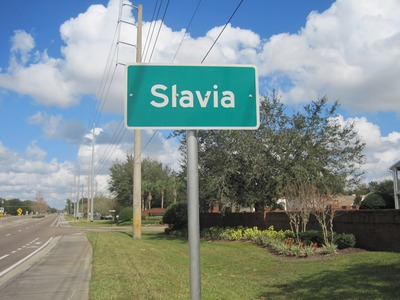
Sources: 1, 2, 3, 4, 5, 6, 7, 8, 9, 10.
Thank you in advance for your support…
We know that you could spend hours, days, weeks and months finding some of this information yourselves – but at this website, we curate the best of what we find for you and place it easily and conveniently into one place. Please take a moment today to recognize our efforts and make a donation towards the operational costs of this site – your support keeps the site alive and keeps us searching for the best of our heritage to bring to you.
Remember, we rely solely on your donations to keep the project going.
We appreciate you more than you know!
If you have not already subscribed to get TresBohemes.com delivered to your inbox, please use the form below now so you never miss another post.

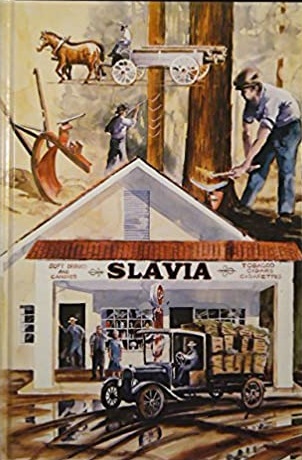



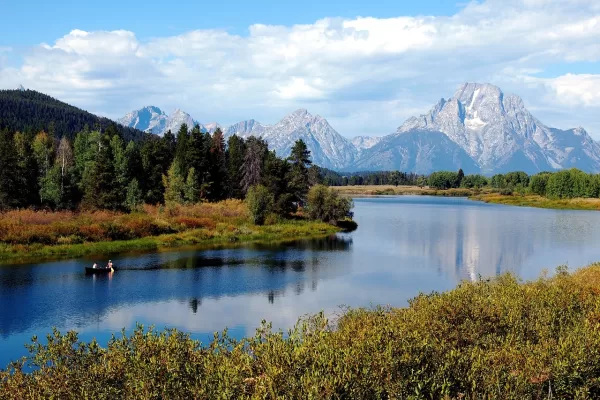
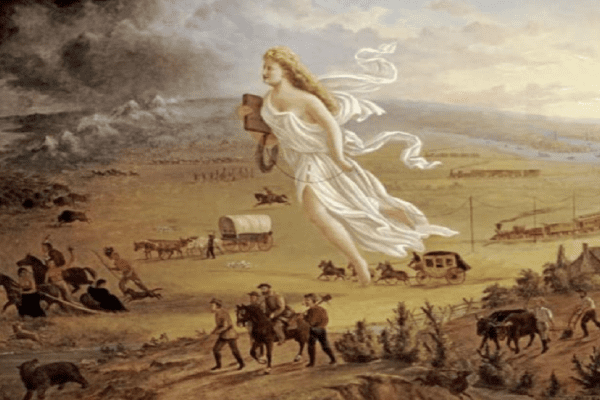
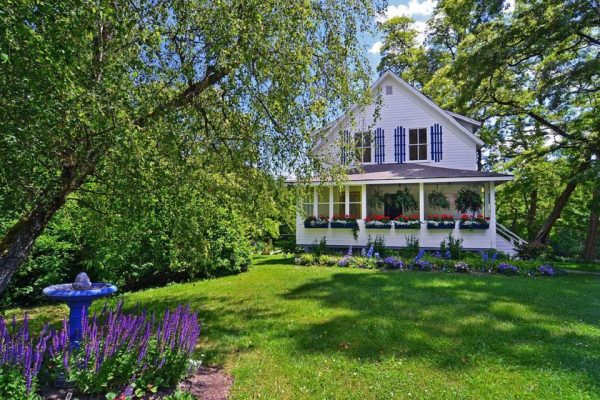















I find it depressing that all of these communities had such fire and passion and have since died out. Where are all the new Czechs and Slovaks at? Based on the census, there are more of us but no one is gathering or building entire communities as they did before. If there was a Czech or Slovak community still active, I would move there in a heartbeat.
I have been in that area so many times and never knew about this history or community. Thanks again for showing me something new.